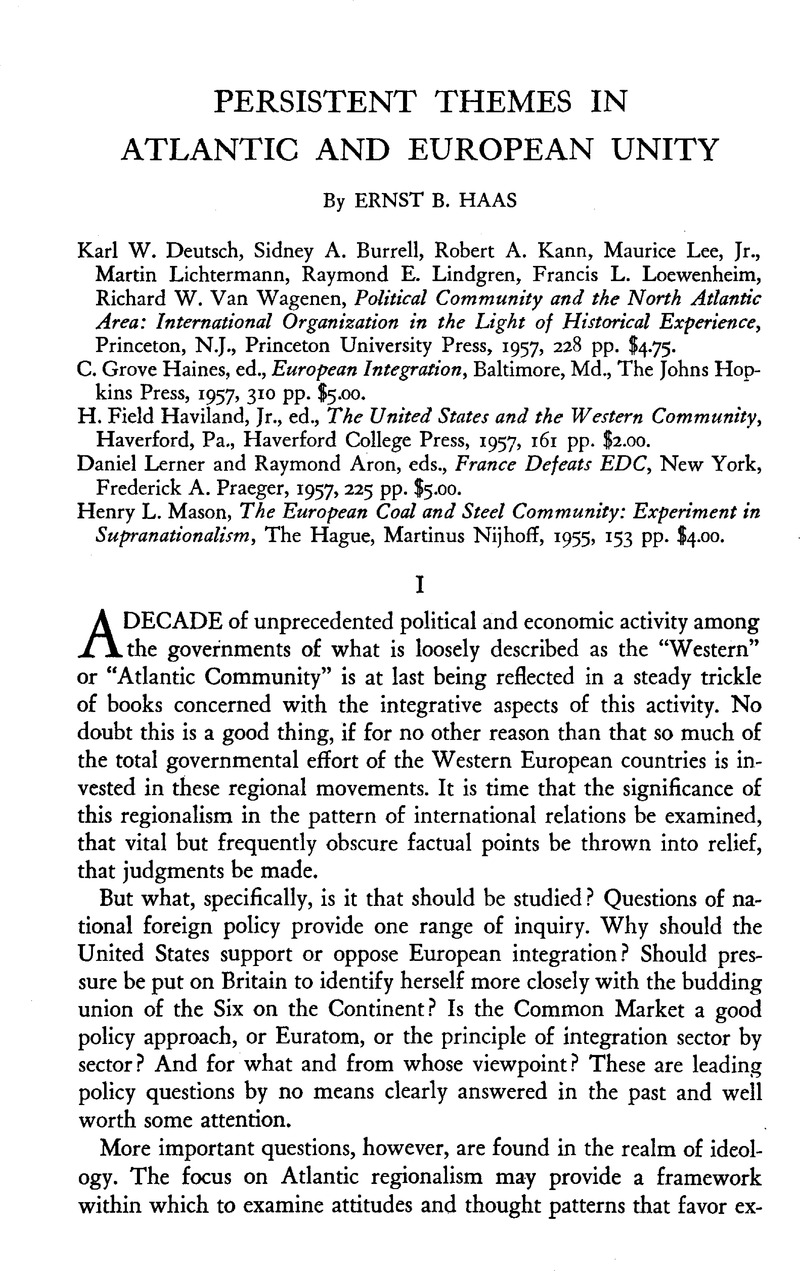Article contents
Persistent Themes in Atlantic and European Unity
Review products
Published online by Cambridge University Press: 18 July 2011
Abstract

- Type
- Review Articles
- Information
- Copyright
- Copyright © Trustees of Princeton University 1958
References
1 Grosser, A., “France and Germany: A Confrontation,” in Lerner and Aron, op.cit., pp. 54–70Google Scholar; “France and Germany,” in Haines, , op.cit., pp. 177–95.Google Scholar Since the groups identified with de Gaulle's rise to power in 1958 have always consistently opposed any European and Atlantic integration which would seriously reduce French independence, no new attitudes or aims are introduced by the demise of the Fourm Republic and our findings remain unchanged.
2 C. E. Carrington, “The British Commonwealth and Western Europe,” in Haines, , op.cit., pp. 279–92Google Scholar; Denis Healy, “Britain's Attitude Towards European Integration,” in Haviland, , op.cit., pp. 31–52.Google Scholar
3 Altiero Spinelli, “The Growth of the European Movement Since World War II,” in Haines, , op.cit., pp. 37–63.Google Scholar
4 Hans Kohn, “Nationalism and the Integration of Europe,” in ibid., pp. 21–36.
5 Henri Brugmans, “The Dynamics of European Integration,” in ibid., pp. 161–76.
8 Aldo Garosci, “Neutralism,” in ibid., pp. 196–214.
9 Charles Malik, “Asian Views of an Integrated Europe,” in ibid., pp. 231–49.
10 E. N. Van Kleffens, “The Case for European Integration: Political Considerations,” in ibid., pp. 80–96; Paul Delouvrier, “Economic Integration: Problems and Possibilities,” in ibid., pp. 114–24; Lincoln Gordon, “Political Integration in the Free World Community,” in Haviland, , op.cit., pp. 65–80Google Scholar; Pierre Uri, “A French View of the Western Community,” in ibid., pp. 81–92.
11 “The Growth of Nations: Some Recurrent Patterns of Political and Social Integration,” World Politics, V, No. 2 (January 1953), pp. 194–95.
12 Lerner, and Aron, , op.cit., p. xi.Google Scholar
13 The cases selected for analysis include: the United States, 1789–1877; England-Scotland, until 1707; England-Ireland, until 1921; German unification, nineteenth century until 1871; Italian unification, Napoleonic Wars until 1860; Hapsburg monarchy, sixteenth century until 1918; Norway-Sweden, 1814–1907; Swiss unification, thirteenth century until 1848; England-Wales, late Middle Ages; unification of England in the Middle Ages. The guiding concepts and methods were derived from Karl Deutsch, W., Nationalism and Social Communication (New York, 1954)Google Scholar and Political Community at the International Level (Garden City, N. Y., 1955).
14 For an elaboration of the fruitful marriage of institutional and behavioral analysis, see Leiserson, Avery, “The Place of Parties in the Study of Politics,” American Political Science Review, LI, No. 4 (December 1957), pp. 943–54.CrossRefGoogle Scholar
- 4
- Cited by


